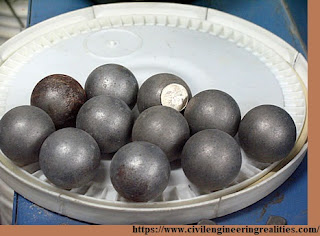Aggregates undergo substantial wear and tear throughout their
life. Generally,
they should be hard and tough enough to resist crushing, degradation and
disintegration from any activities.
This
test is performed by AASHTO T96 or ASTM C131: for resistance to small size
coarse aggregation by abrasion and impact in a Los Angeles machine.
Los
Angeles's abrasion test on aggregates is
a measure of aggregate toughness and abrasion resistance such as crushing,
corrosion and disintegration. Aggregate abrasion characteristics are important
because the component aggregates in HMA (Hot Mix Asphalt) must resist crushing,
degradation, and disintegration to produce high quality HMA.
Principle of the Test:
To
produce the abrasive action by use of standard steel balls which when mixed
with the aggregate and rotated in a drum for specific number of revolution
cause impact on aggregate. The %age wear due to rubbing with steel balls is
determined and is known as abrasion value.
Prepare
the sample by the portion of an aggregate sample retained on the 1.70 mm sieve
and place in a large rotating drum that contains a shelf plate attached to the
outer wall.
Apparatus
required:
1.Steel Spherical Balls- Cast iron or steel balls, approximately 48mm in
diameter and each weighing between 390 to 445 g; six to twelve balls are
required.
2.Los
Angeles Machine
(The machine is equipped with a counter. The machine shall consist of hollow
steel cylinders closed at both ends. An opening shall be provided in the
cylinder to present the specimen.
3.Sieves-1.70, 2.36, 4.75, 6.3, 10, 12.5, 20, 25, 40, 50, 63, 80 mm IS
Sieves.
4.Balance
of capacity 5 kg or 10 kg.
5.Drying
oven and tray.
Los Angeles Abrasion Test
Procedure for Los Angeles Test:
1.The test specimen
consists of clean aggregates dried in an oven at 105 ° - 110 ° C. The sample
must correspond to any of the grading shown in Table 1.
2.Select the grading
used in the test in such a way that it conforms to the grading used in the
construction, to the maximum extent possible.
3.Take a sample of 5 kg
for grading A, B, C and D and 10 kg for grading E, F & G.
4.Depending on the
grading of the aggregate, choose the abrasive charge according to Table 2.
5.Place aggregates and
abrasive charges on the cylinder and fix the cover.
6.Rotate the machine at
a speed of 30 to 33 revolutions per minute. The number of revolutions is 500
for A, B, C and D and 1000 for grading E, F & G. The machine must be
balanced and operated so that there is equal peripheral speed.
7.The machine is
stopped after the desired number of revolutions and the material is discharged into a tray.
8.The entire stone dust
is sieved on a 1.70 mm IS sieve.
9.A material thicker
than 1.7 mm in size weighs up to one gram.
 |
| Table-1:Grading of test samples |
Test Suitability:
The
L.A. Abrasion test is an empirical test; it is not directly related to field
performance of aggregates.
Field
observations generally do not show a good relationship between L.A. abrasion
values and field performance.
L.A. abrasion loss is unable to predict field
performance.
 |
| Table 2- Abrasion charge |
Uses & Significance of Los Angeles Abrasion Test :
For an aggregate to perform satisfactory in pavement, it must be sufficiently hard to resist the abrasive effect of traffic over long period of time. The soft aggregates will be quickly ground to dust, whilst the hard aggregates are quite resistant to crushing effect.
The test also will determine the quality of the aggregate.
The
L.A. Abrasion test is widely used as an indicator of the relative quality or
competence of mineral aggregates.
Recommended Los
Angeles Test Values for Pavements
Los
Angeles test is commonly used to evaluate the hardness of aggregates. The test
has more acceptability because the resistance to abrasion and impact is
determined simultaneously.
Depending upon the value, the suitability of aggregates for different road constructions can be judged as per IRC specifications as given:
|
S.No. |
Type of Pavement |
Max. permissible abrasion value in % |
|
1 |
Water bound macadam sub base course |
60 |
|
2 |
WBM base course with bituminous surfacing |
50 |
|
3 |
Bituminous bound macadam |
50 |
|
4 |
WBM surfacing course |
40 |
|
5 |
Bituminous penetration macadam |
40 |
|
6 |
Bituminous surface dressing, cement concrete surface course |
35 |
|
7 |
Bituminous concrete surface course |
30 |
Original weight of aggregate sample = W1 gm
Weight of aggregate sample retained = W2 gm
Weight passing 1.7mm IS sieve = W1 – W2 gm
Abrasion Value = (W1 – W2 ) / W1 X 100
 |
| Table-3: Abrasion test values |
Results:
Average Los Angeles Abrasion Value (from table-3) = 14.94


Post a Comment